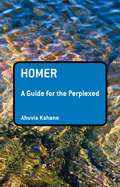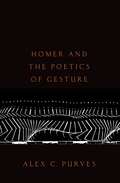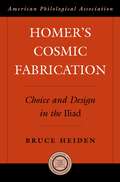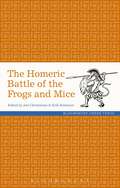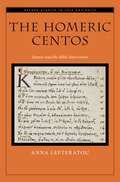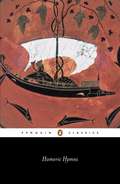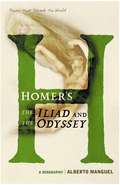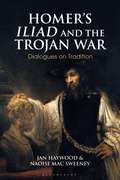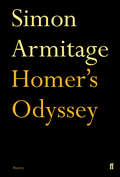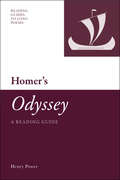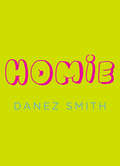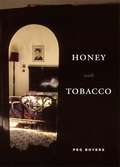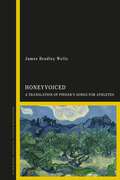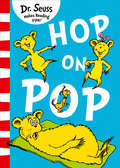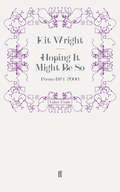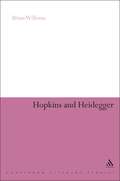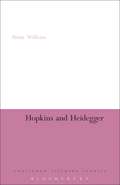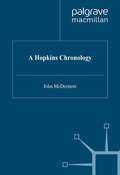- Table View
- List View
Homer: Authority And Continuity In Homer And The Homeric Tradition (Guides for the Perplexed #257)
by Ahuvia KahaneShortlisted for the Runciman Award 2013Homer's poetry is widely recognized as the beginning of the literary tradition of the West and among its most influential canonical texts. Outlining a series of key themes, ideas, and values associated with Homer and Homeric poetry, Homer: A Guide for the Perplexed explores the question of the formation of the Iliad and the Odyssey - the so-called 'Homeric Problem'. Among the main Homeric themes which the book considers are origin and form, orality and composition, heroic values, social structure, and social bias, gender roles and gendered interpretation, ethnicity, representations of religion, mortality, and the divine, memory, poetry, and poetics, and canonicity and tradition, and the history of Homeric receptions. Drawing upon his extensive knowledge of scholarship on Homer and early epic, Ahuvia Kahane explores contemporary critical and philosophical questions relating to Homer and the Homeric tradition, and examines his wider cultural impact, contexts and significance. This is the ideal companion to study of this most influential poet, providing readers with some basic suggestions for further pursuing their interests in Homer.
Homer and His Iliad
by Robin Lane FoxA thrilling study of the greatest of all epic poems, by one of the world's leading classicistsHomer's Iliad is the famous epic poem set among the tales of Troy. Its subject is the anger of the hero Achilles and its dreadful consequences for the warring Greeks and Trojans. It was composed more than 2,600 years ago, but still transfixes us with its tale of loss and battle, love and revenge, guided throughout by the active presence of the gods. Its beauty and profound bleakness are intensely moving but great questions remain: where, how and when it was composed and why it has such enduring power?In this compelling book Robin Lane Fox addresses these questions, drawing on a life-long love and engagement with the poem. He argues for a place, a date and a method for its composition, giving us a sense of alternative approaches and grounding his own in discoveries about long heroic poems composed elsewhere in the world, and the ever-growing evidence of archaeology.Unlike other books on the Iliad, this one combines the detailed expertise of a historian with the sensitivity of a teacher of it as poetry. Lane Fox goes on to consider hallmarks of the poem, its values, implicit and explicit, its characters, its women, its gods and even its horses. He argues repeatedly for its beautiful observation and addresses its parallel use of what is, to us, the natural world. Thousands of readers turn to the Iliad every year. In this superbly written and conceived tribute, Lane Fox expresses and amplifies what old and new readers can find in it. It is pervaded, he argues, by a poignant hardness which is not just a poetic trick. It is a deeply held view of the world.
Homer and the Poetics of Gesture
by Alex C. PurvesHomer and the Poetics of Gesture is the first book of its kind to consider the epic formula in terms that are gestural as well as verbal. Drawing on studies from multiple disciplines, including movement theory, dance studies, phenomenology, and early film, it suggests new approaches for interpreting the relationship between repetition and embodiment in Homer. Through a series of dynamic close readings, Purves argues that the deep-seated habits and gestures of epic bodies are instrumental to our understanding of the Iliad and Odyssey, especially insofar as they attune us to the kinetic structures and sensibilities that shape the meaning of the poems. Each of the chapters isolates a scene in which a specific action, posture, or gesture (falling, running, leaping, standing, and reaching) emerges from the background of its other iterations in order to make larger claims about its poetic significance within the epics as a whole. Beginning from the premise that gestures are shared between characters and often identically repeated within the poems' formulaic system, the book reconsiders long-standing arguments about Homeric agency and character by focusing on those moments when a gesture diverges from its expected course, redirecting the plot or drawing the poem in new and surprising directions. Homer and the Poetics of Gesture not only affords new insights into the nature of epic repetition and poetic originality but also reveals unnoticed connections between Homeric structure and technique and the embodied habits and movements of the characters within the poems.
Homer and the Poetics of Gesture
by Alex C. PurvesHomer and the Poetics of Gesture is the first book of its kind to consider the epic formula in terms that are gestural as well as verbal. Drawing on studies from multiple disciplines, including movement theory, dance studies, phenomenology, and early film, it suggests new approaches for interpreting the relationship between repetition and embodiment in Homer. Through a series of dynamic close readings, Purves argues that the deep-seated habits and gestures of epic bodies are instrumental to our understanding of the Iliad and Odyssey, especially insofar as they attune us to the kinetic structures and sensibilities that shape the meaning of the poems. Each of the chapters isolates a scene in which a specific action, posture, or gesture (falling, running, leaping, standing, and reaching) emerges from the background of its other iterations in order to make larger claims about its poetic significance within the epics as a whole. Beginning from the premise that gestures are shared between characters and often identically repeated within the poems' formulaic system, the book reconsiders long-standing arguments about Homeric agency and character by focusing on those moments when a gesture diverges from its expected course, redirecting the plot or drawing the poem in new and surprising directions. Homer and the Poetics of Gesture not only affords new insights into the nature of epic repetition and poetic originality but also reveals unnoticed connections between Homeric structure and technique and the embodied habits and movements of the characters within the poems.
The Homeric Battle of the Frogs and Mice (Greek Texts)
by Joel P. Christensen Erik RobinsonThis book offers students of Greek and scholars interested in Greek literature the first English-language commentary on the “Battle of Frogs and Mice”, a short animal epic ascribed to Homer in the ancient world. The book includes a contextualizing introduction covering issues of literary genre, literary history and the language of Homeric Greek. In addition to a revised Greek text, the volume also offers a new translation of the poem. The commentary furnishes readers with extensive linguistic and literary information so that they may investigate the problem of the poem's character and authorship on their own. A full vocabulary at the back ensures this is a one-stop shop for students reading the poem.
The Homeric Battle of the Frogs and Mice (Greek Texts)
by Joel P. Christensen Erik RobinsonThis book offers students of Greek and scholars interested in Greek literature the first English-language commentary on the “Battle of Frogs and Mice”, a short animal epic ascribed to Homer in the ancient world. The book includes a contextualizing introduction covering issues of literary genre, literary history and the language of Homeric Greek. In addition to a revised Greek text, the volume also offers a new translation of the poem. The commentary furnishes readers with extensive linguistic and literary information so that they may investigate the problem of the poem's character and authorship on their own. A full vocabulary at the back ensures this is a one-stop shop for students reading the poem.
The Homeric Centos: Homer and the Bible Interwoven (OXFORD STUDIES IN LATE ANTIQUITY SERIES)
by Anna LefteratouThe Homeric Centos, a poem that is Homeric in style and biblical in theme, is a dramatic illustration of the creative cultural and religious dialogue between Classical Antiquity and Christianity taking place in the Roman Empire during the fifth century CE. The text is attributed to Eudocia, empress and poet, who died in exile in the Holy Land ca. 460. With lines drawn verbatim from Homer's Iliad and Odyssey, the poem begins with the Creation and Fall and ends with Jesus' Resurrection and Ascension. In this blend of Homeric style and Christian themes, there are also echoes of Classical and classicising literature, stretching from Homer and drama to imperial literature. Equally prominent are echoes of earlier Christian canonical and apocryphal works, verse models, and theological works. In The Homeric Centos: Homer and the Bible Interwoven, Anna Lefteratou analyzes the double inspiration of the poem by both classical and Christian traditions. This book explores the works relationship with the cultural milieu of the fifth century CE and offers in-depth analysis of the scenes of Creation and Fall, and Jesus' Passion, Resurrection, and Ascension. This book exposes the work's debt to centuries of Homeric reception and interpretation as well as Christian literature and exegesis, and places it at the crossroads of Christian and pagan literary traditions.
The Homeric Centos: Homer and the Bible Interwoven (OXFORD STUDIES IN LATE ANTIQUITY SERIES)
by Anna LefteratouThe Homeric Centos, a poem that is Homeric in style and biblical in theme, is a dramatic illustration of the creative cultural and religious dialogue between Classical Antiquity and Christianity taking place in the Roman Empire during the fifth century CE. The text is attributed to Eudocia, empress and poet, who died in exile in the Holy Land ca. 460. With lines drawn verbatim from Homer's Iliad and Odyssey, the poem begins with the Creation and Fall and ends with Jesus' Resurrection and Ascension. In this blend of Homeric style and Christian themes, there are also echoes of Classical and classicising literature, stretching from Homer and drama to imperial literature. Equally prominent are echoes of earlier Christian canonical and apocryphal works, verse models, and theological works. In The Homeric Centos: Homer and the Bible Interwoven, Anna Lefteratou analyzes the double inspiration of the poem by both classical and Christian traditions. This book explores the works relationship with the cultural milieu of the fifth century CE and offers in-depth analysis of the scenes of Creation and Fall, and Jesus' Passion, Resurrection, and Ascension. This book exposes the work's debt to centuries of Homeric reception and interpretation as well as Christian literature and exegesis, and places it at the crossroads of Christian and pagan literary traditions.
The Homeric Hymns: A New Prose Translation, And Essays, Literary And Mythological (Select Bibliographies Reprint Ser.)
by Homer Nicholas Richardson Jules CashfordComposed for recitation at festivals, these 33 songs were written in honour of the gods and goddesses of the ancient Greek pantheon. They recount the key episodes in the lives of the gods, and dramatise the moments when they first appear before mortals. Together they offer the most vivid picture we have of the Greek view of the relationship between the divine and human worlds.
Homer's "Iliad" and "Odyssey": A Biography
by Alberto ManguelA worldwide exploration of the history, purpose, and inescapable influence of the Iliad and the Odyssey that will inspire readers to think anew about Homer’s work No one knows whether Homer was a real person, but there is no doubt that the epic poems assembled under his name are foundations of Western literature. The Iliad and the Odyssey—with their tales of the Trojan War, Achilles, Odysseus and Penelope, the Cyclops, the beautiful Helen of Troy, and the petulant gods—have inspired us for over two and a half millennia and influenced writers from Plato to Virgil, Pope to Joyce, and Dante to Margaret Atwood. In this graceful and sweeping book, Alberto Manguel traces the lineage of Homer’s poems. He examines their original purpose, either as allegory or record of history; surveys the challenges the pagan poems presented to the early Christian world; and looks at their reception after the Reformation through the present day. In this revised and expanded edition, Manguel ignites new ways of thinking about these classic works.
Homer's The Iliad and The Odyssey: A Biography (A Book that Shook the World) (BOOKS THAT SHOOK THE WORLD #9)
by Alberto ManguelThe stories of the Trojan war and Helen of Troy, Patroclus and Achilles, the Sirens and the Cyclops are embedded in western culture, yet readers often fail to recognise that they were made famous by two epic poems, The Iliad and The Odyssey, and one blind poet: Homer. Alberto Manguel begins his book with the poems' inception in ancient Greece and demonstrates how these poems have reverberated subsequently through the western canon, from the Rome of Virgil and Horace to Joyce's Dublin and Derek Walcott's Caribbean, via Dante and Racine. In this lyrical and graceful short volume, Manguel delights in the original poems and celebrates their presence throughout history.
Homer’s Iliad and the Trojan War: Dialogues on Tradition (Bloomsbury Studies in Classical Reception)
by Naoise Mac Sweeney Jan HaywoodIn this new volume, Jan Haywood and Naoíse Mac Sweeney investigate the position of Homer's Iliad within the wider Trojan War tradition through a series of detailed case studies. From ancient Mesopotamia to twenty-first century America, these examples are drawn from a range of historical and cultural contexts; and from Athenian pot paintings to twelfth-century German scholarship, they engage with a range of different media and genres. Inspired by the dialogues inherent in the process of reception, the book adopts a dialogic structure. In each chapter, paired essays by Haywood and Mac Sweeney offer contrasting authorial voices addressing a single theme, thereby drawing out connections and dissonances between a diverse suite of classical and post-classical Iliadic receptions. The resulting book offers new insights, both into individual instances of Iliadic reception in particular historical contexts, but also into the workings of a complex story tradition. The centrality of the Iliad within the wider Trojan War tradition is shown to be a function of conscious engagement not only with Iliadic content, but also with Iliadic status and the iconic idea of the Homeric.
Homer’s Iliad and the Trojan War: Dialogues on Tradition (Bloomsbury Studies in Classical Reception)
by Naoise Mac Sweeney Jan HaywoodIn this new volume, Jan Haywood and Naoíse Mac Sweeney investigate the position of Homer's Iliad within the wider Trojan War tradition through a series of detailed case studies. From ancient Mesopotamia to twenty-first century America, these examples are drawn from a range of historical and cultural contexts; and from Athenian pot paintings to twelfth-century German scholarship, they engage with a range of different media and genres. Inspired by the dialogues inherent in the process of reception, the book adopts a dialogic structure. In each chapter, paired essays by Haywood and Mac Sweeney offer contrasting authorial voices addressing a single theme, thereby drawing out connections and dissonances between a diverse suite of classical and post-classical Iliadic receptions. The resulting book offers new insights, both into individual instances of Iliadic reception in particular historical contexts, but also into the workings of a complex story tradition. The centrality of the Iliad within the wider Trojan War tradition is shown to be a function of conscious engagement not only with Iliadic content, but also with Iliadic status and the iconic idea of the Homeric.
Homer's Odyssey: A Dramatic Retelling Of Homer's Epic
by Simon ArmitageOriginally commissioned for BBC Radio, Simon Armitage recasts Homer's epic as a series of dramatic dialogues. His version bristles with the economy, wit and guile that we have come to expect from one of the most individual voices of his generation.
Homer's 'Odyssey': A Reading Guide (Reading Guides to Long Poems)
by Henry PowerA fresh and exciting approach to this great work of classical literature, which brings it alive for today's students and gives them the tools to appreciate and explore the work themselves.
Homie: Poems
by Danez Smith"& colin kaepernick is my president, who kneels on the airbent toward a branch, throwing apples down to the children & vets& rihanna is my president, walking out of global summitswith wine glass in hand, our taxes returned in goldto dust our faces into coins& my mama is my president, her grace stuntson amazing, brown hands breaking brown bread overmouths of the hungry until there are none unfed & my grandma is my president & her cabinet is her cabinetcause she knows to trust what the pan knowshow the skillet wins the war" —from 'my president'Danez Smith is our President.A mighty anthem about the saving grace of friendship, Danez Smith's highly anticipated collection Homie is rooted in their search for joy and intimacy in a time where both are scarce. In poems of rare power and generosity, Smith acknowledges that in a country overrun by violence, xenophobia and disparity, and in a body defined by race, queerness, and diagnosis, it can be hard to survive, even harder to remember reasons for living. But then the phone lights up, or a shout comes up to the window, and family — blood and chosen — arrives with just the right food and some redemption. Part friendship diary, part bright elegy, part war cry, Homie is written for friends: for Danez’s friends, for yours.
Honey with Tobacco (Phoenix Poets)
by Peg BoyersPietà This time the migraine came with a vision bathed in night sweat: I was sitting on the Eames chair, your man’s body on my lap, legs and arms white as casein draped over mine, spilling onto the cassock, new sores on your legs, dried blood on your feet and hands, from your chalk mouth the words forgive me, from mine, the impossible no Hard Bread,Peg Boyers’s debut poetry collection, with verse spoken in the imagined voice of the Italian writer Natalia Ginzburg, was widely praised for its inspired ventriloquism and its brilliant lyricism. In Honey with Tobacco, Boyers’s own intensely personal voice emerges in three strikingly distinctive variants. The first part of the book is the most explicitly autobiographical, bringing together poems that explore the poet’s Cuban American experience and a childhood marked by travel, the tropics, and varieties of disenchantment. The middle sequence of poems concerns a mother, a father, and a son, a postmodern holy family whose ordeals are evoked in a terse, terrifying narrative. In familiar tableaux drawn from the Bible that have inspired great works of art—the Annunciation, the Pieta, and Judgment Day—Boyers explores what it means in contemporary America to be “blessed among women” and whether and how art can contain grief. The final section of the book confronts age, desire, and regret in a series of personal poems that plumb baser human instincts and the speakers’ determination to dwell in darkness, when necessary, without abandoning the sacred. Praise for Hard Bread: “A great achievement of poetic voice . . . . It’s absolutely clear what these poems are ‘about,’ and they are unapologetic in their devotion to subject, clarity, precision, and accessibility.”—Steven Cramer, Poetry
HoneyVoiced: A Translation of Pindar’s Songs for Athletes
by Dr James Bradley WellsThis new translation of Pindar's songs for victorious athletes marries philological rigour with poetic sensibility in order to represent the beauty of his language for a modern audience as closely as possible. Pindar's poetry is synonymous with difficulty for scholars and students of classical studies. His syntax stretches the limits of ancient Greek, while his allusions to mythology and other poetic texts assume an audience that knows more than we now possibly can, given the fragmentary nature of textual and material culture records for ancient Greece. It includes an authoritative introduction, both to the poet and his art and to ancient athletics, alongside brief orientations to the historical context and mythological content of each victory song. The inclusion of a glossary supplies additional mythological and historical information necessary to understanding Pindar's poetry for those coming to the works for the first time. His is the largest body of textual remains that exists for ancient Greece between Homer (conventionally dated to 750 BCE) and the Classical Period (480–323 BCE), and constitutes a rich resource for politics, history, religion, and social practices.
HoneyVoiced: A Translation of Pindar’s Songs for Athletes
by Dr James Bradley WellsThis new translation of Pindar's songs for victorious athletes marries philological rigour with poetic sensibility in order to represent the beauty of his language for a modern audience as closely as possible. Pindar's poetry is synonymous with difficulty for scholars and students of classical studies. His syntax stretches the limits of ancient Greek, while his allusions to mythology and other poetic texts assume an audience that knows more than we now possibly can, given the fragmentary nature of textual and material culture records for ancient Greece. It includes an authoritative introduction, both to the poet and his art and to ancient athletics, alongside brief orientations to the historical context and mythological content of each victory song. The inclusion of a glossary supplies additional mythological and historical information necessary to understanding Pindar's poetry for those coming to the works for the first time. His is the largest body of textual remains that exists for ancient Greece between Homer (conventionally dated to 750 BCE) and the Classical Period (480–323 BCE), and constitutes a rich resource for politics, history, religion, and social practices.
Hop On Pop (Beginner Books(r) Ser.)
by Dr. SeussThis charming book introduces young children to words that rhyme, with classic Dr. Seuss fun!
Hoping It Might Be So: Poems 1974-2000
by Kit WrightHoping It Might Be So brings together all of Kit Wright's previous collections for adults as well as three dozen new poems. The collection, first published in 2000, was described by Christina Patterson in the Sunday Times as 'funny and profoundly humane' and by Sophie Hannah in the PN Review as 'full of verve and energy, with a strong musical quality that makes you want to read on and hear more'. Sean O'Brien in the Times Literary Supplement described Kit Wright as 'a masterly yet modest poet' while Ruth Padel in the Independent on Sunday said that 'all through his work there is that poignancy, darkness, brush with despair, which marks great comic work.' The poet Anthony Wilson said that Wright 'can be funny, serious and moving, and sometimes all three in the space of a single poem'.Hoping It Might Be So is a rewarding collection from an interesting, prolific and lively poet whose poems range from ribald to grief-stricken, elegiac to rambunctious
Hopkins and Heidegger (Continuum Literary Studies)
by Brian WillemsHopkins and Heidegger is a new exploration of Gerard Manley Hopkins' poetics through the work of Martin Heidegger. More radically, Brian Willems argues that the work of Hopkins does no less than propose solutions to a number of hitherto unresolved questions regarding Heidegger's later writings, vitalizing the concepts of both writers beyond their local contexts. Willems examines a number of cross-sections between the poetry and thought of Hopkins and the philosophy of Heidegger. While neither writer ever directly addressed the other's work - Hopkins died the year Heidegger was born, 1899, and Heidegger never turns his thoughts on poetry to the Victorians - a number of similarities between the two have been noted but never fleshed out. Willems' readings of these cross-sections are centred on Hopkins' concepts of 'inscape' and 'instress' and around Heidegger's reading of both appropriation (Ereignis) and the fourfold (das Geviert). This study will be of interest to scholars and postgraduates in both Victorian literature and Continental philosophy.
Hopkins and Heidegger (Continuum Literary Studies #191)
by Brian WillemsHopkins and Heidegger is a new exploration of Gerard Manley Hopkins' poetics through the work of Martin Heidegger. More radically, Brian Willems argues that the work of Hopkins does no less than propose solutions to a number of hitherto unresolved questions regarding Heidegger's later writings, vitalizing the concepts of both writers beyond their local contexts. Willems examines a number of cross-sections between the poetry and thought of Hopkins and the philosophy of Heidegger. While neither writer ever directly addressed the other's work - Hopkins died the year Heidegger was born, 1899, and Heidegger never turns his thoughts on poetry to the Victorians - a number of similarities between the two have been noted but never fleshed out. Willems' readings of these cross-sections are centred on Hopkins' concepts of 'inscape' and 'instress' and around Heidegger's reading of both appropriation (Ereignis) and the fourfold (das Geviert). This study will be of interest to scholars and postgraduates in both Victorian literature and Continental philosophy.
A Hopkins Chronology (Author Chronologies Series)
by J. McDermottThis Hopkins chronology describes the poet's family and early education, then gives a day-by-day account of what he was doing, reading and writing, and the people he met. Drawing on some material not published before, it illustrates the working life of a priest-poet whose work was not made public until more than thirty years after his death. There are additional sections on the religious and political background of a major Victorian writer whose life was essentially enigmatic and private.
